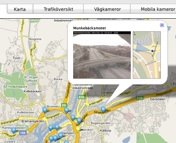Today, I had the opportunity to study a small yet powerful field experiment at the County Administrative Board of Västra Götaland. The county administrative board has a geographical responsibility for crisis preparedness and crisis response at the regional level. The field experiment took place at the county administrative board’s newly designed situation room facilities.
At the field experiment, the TiB-organization (the duty officers) tested new ways of conducting multi-actor situation reporting conferences. In a series of small scale, yet cleverly designed, sessions, the duty officer invited three different fire & rescue services, the police, the paramedic organization, the national 112-organization, the traffic authority and the Swedish meteorological and hydrological institute to participate in a multi-actor situation conference.
Until now, such conferences have mainly been done in the form of a multi-actor teleconference, where verbal reports are the mechanism for sharing information. But today, the multi-actor conference was mediated using collaborative tools, opening up for a richer set of mechanisms for information sharing.
The field experiment provided several insights regarding the delicate balance of striving for improved communication capabilities while at the same time keeping a strong attention to avoid the addition of unwanted side-effects. The session today also showed how a cleverly designed field experiment can be accomplished without creating a hyped expectation bubble that most experiments rarely are able to fulfill. The county administrative board presented great skills in running a field experiment that was nicely embedded into the ongoing discussions on how to further improve multi-actor situation reporting.
Many thanks to Marcus Green, Charlotta Källerfeldt, Maria Göransson for arranging the event, and also many thanks to Malin Lintzen, Per Marklund, and Per-olof Hårsmar (SMHI) for the experimental design.











